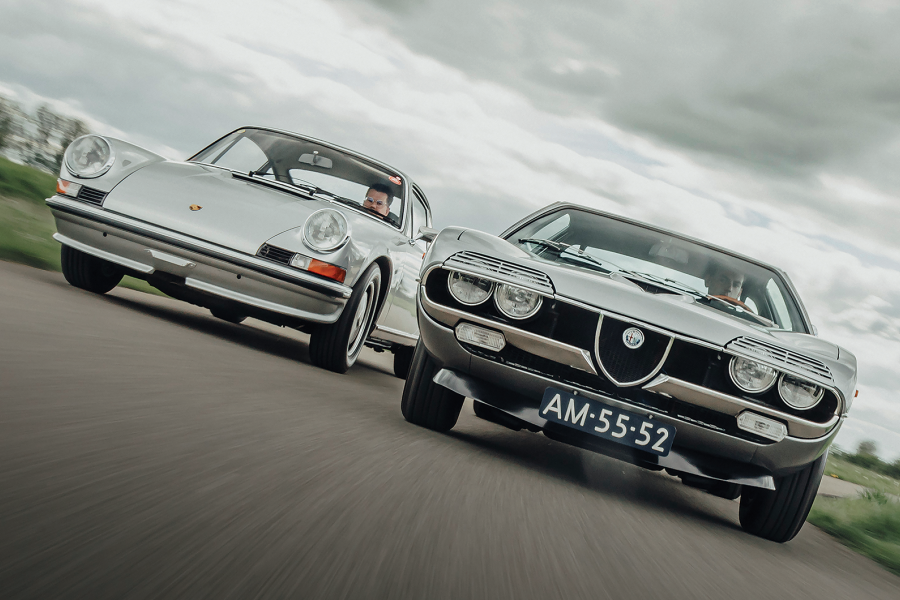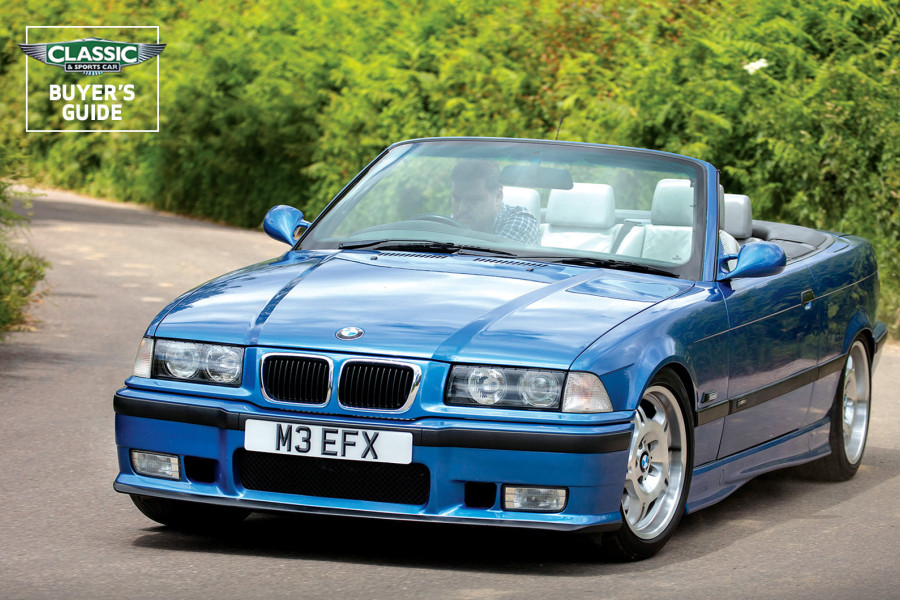Depending on the car, this is either fantastic or it can feel like a supermarket trolley with a wonky wheel.
Its unladen nose and excessive front spring-rating cultivate a trust issue with what could almost be mistaken for wheel imbalance or bump-steer.
Not here, though. On bone-dry roads and steered with gentle hands, there is no sign of the Porsche’s psychotic alter ego Mr Hyde and, to be blunt, only a loon would bin a classic 930 in this day and age. Weight distribution and transfer? Balance? None are an issue.
At speed, this 911 is stable and trustworthy on the straights. Yet it wilfully slices into an apex without the evil monkey of doubt perched upon your shoulder.
The steering – a powerful sermon against the over-indulgence of power assistance – is light, consistent and forthcoming.
Roll is scarcely sniffed, while the turbo manages to ride the ups, downs and imperfections of these fast undulating roads in a manner that shames many a modern car.
Exiting bends, esses and corners, the Porsche’s traction really is impeccable, which is just as well.
The gearchange might be a bit crotchety and occasionally crunchy on engagement, but you don’t have to bother with it.
The engine dominates with its soundtrack and an output as mighty and seamless as Sizewell B.
Compared with a 3-litre unit, the intercooled 3.3 (18,770 of which were built) does not shout its turbocharged intentions, but as Eatough says: “When it’s on boost, you know it!”
The air-cooled flat-six and turbo merrily co-operate, and despite the overriding position of the tacho, eyes remain stuck to the laminated view ahead.
Christ! This really has some muscle. We’re not talking 2016 so-fast-it’s uncomfortable pace, but an enjoyable 0-100mph in 12 secs quick
And thanks to its manageable width (at 5ft 10in, it is a scarcely believable 10½in narrower than the current Vauxhall Astra), the speed is easy to wield.
Second gear and the right brogue goes deep. Past bass-rich resonance, escalating into a soulful, almost Motown V8 groove – accompanied by fluttering cam gear – and it all dissolves into a sensual guts ’n’ glory bellow. What a performance, and surely worthy of another encore.
In the past, I’ve been resolute in my heathen disbelief of the flat-six Porsche, sat in a bewildered minority as the world and its dog works itself into a frothing frenzy like critics at the Turner Prize.
If, however, my avowed 911 atheism had started to creak, crack and crumble following a 3-litre encounter, this corking turbo has blown it apart and left it in smithereens.
Saab 99 turbo
Since 1968, Svenska Aeroplan Aktiebolaget had been offering a new, larger sister to its 96 – the Sixten Sason-designed 99.
Competing in the compact executive class, the latest son of Trollhättan continued the no-nonsense company’s dissident, quirky ethos – an approach that shunned compromise on engineering integrity.
The 99 was powered by a unit based on Triumph’s slant-four – later improved and built by Saab itself following BL quality woes (at which point it was renamed the Saab B engine).
The route to more power initially involved a plan to use the Stag V8, but with that bullet dodged (the prospect of a thoroughly debugged Saab-built V8 is actually quite tantalising), the Swedes turned to a device that had been employed in aero engines since the 1920s: the turbocharger.
After thorough development – they ran 100 prototypes for a total of 2.9 million miles – the £7850 Saab 99 Turbo was launched with the three-door Combi coupé body in 1978.
This was joined the following year by a two-door version that would homologate the model for rallying.
Toting a chain-driven, single-overhead-cam 1985cc engine with 7.5:1 compression ratio, Bosch fuel injection, a Garrett turbo, altered cam timing, sodium-filled exhaust valves and an oil cooler, this ‘four’ packed a punch far beyond its cubic means.
It gave 145bhp at 5000rpm with 174lb ft at 3000rpm, representing an increase in output over the normally aspirated car of 23% more power and 45% more torque.
While the Combi managed 0-60mph in 8.9 secs and a top speed just short of 120mph, the lighter two-door was even quicker, nailing 0-60mph in 8.5 secs and going on to exceed two miles per minute.
Driven by Stig Blomqvist and Per Eklund, the 99 Turbo would be Saab’s last works rally entrant, its career cut short by the arrival of the Audi quattro, ballooning budgets and Group B.
But while the model was denied a trophy haul to rival that of the 96, the 99 Turbo would blow the motoring press off its feet.
In period, Motor reported: ‘Having experienced Turbo motoring first hand, we can see why Saab has so much faith in the machine: it’s exceptional’.
On another occasion, it said: ‘Between 40 and 100mph, the Saab accelerates faster than just about any four-seater saloon in the world. And that means overtaking and cross-country ability of the sort hitherto the preserve of expensive exotica.’
Autocar, meanwhile, candidly admitted: ‘Occasionally a car comes along which shocks [our] seen-it-all, driven-them-all staff… Such a car is Saab’s Turbo.’
Owner David Dallimore bought his 99 new in 1980. It’s one of 600 homologation two-doors built (400 red cars were produced at Trollhättan, with another 200 black examples constructed by Saab-Valmet in Uusikaupunki, Finland).
“I kept hold of it because it just kept going,” he says. “It’s only had one mechanical problem – the jackshaft that drives the water pump – and one electrical issue, which was a manufacturing fault in the Bosch alternator.
“It’s the engineering on them – that’s why I bought it originally. They’re over-engineered, and, as a family saloon, it can raise a smile when you feel the need.”
The 99 Turbo is the subtle member of our trio. As our photographs are taken, the Saab has bided its time, the German pair seeming to competitively flex their go-faster stripes or brandish their spoilers for spotlight glory.
The black paint conceals the 99’s idiosyncratic prettiness, its performance apparel limited to subtle touches to the bumpers and rear lamps, a front airdam and ‘Inca’ turbine blade alloys.
The interior fixtures and fittings owe a lot to lesser 99s; only the Turbo’s self-conscious boost gauge heralds this car as being a forced-induction model.
The three main instruments have a whiff of the military about them, a ribbon of treen-effect Fablon flutters across the dash, while those bright velour seats appear to be trimmed in Jason King’s dressing gown.
In the process of making yourself at home, you are unwittingly serenaded by Saab-ness.
You notice compact window winders that are so effortless and high-geared they make electric ones a pointless gimmick.
Then there are intuitive, easy-to-use adjustors on the side of the seat and, for the driver, a thermostatically controlled heated seat.
Then there’s the upright windscreen, set into a slim-pillared glasshouse that even among classics sets a precedent for all-round visibility and primary safety.
Twist the ignition key, which, of course, is down between the front seats.
The pedals and steering wheel are offset to the left, but the 99 more than compensates for this minor inconvenience with a four-speed ’box that shames the Teutonic pair.
It has a wonderfully oiled action with such a clear positive gate and sensible throw that, within yards, it feels as if the gearstick and your left hand have been chums for years.
Sometimes, single-minded engineering longevity comes at the expense of a driving experience that is as sparkling and titivating as a stale bun.
Yet, with its promising specification of all-round coil springs, front double wishbones, rack-and-pinion steering and solidly located rear beam axle, the Saab delivers fun aplenty.
Grip is plentiful and the ride is polished, yet it jubilantly scampers around corners with the appetite of a hot hatch, seldom bothering its disc brakes. The steering’s weight, gearing and feedback all earn high marks.
Build the revs to 3000rpm, and from there you experience the turbo’s solid, faultless shove all the way up to 5000rpm.
Only beyond peak power – heading toward the 5500rpm redline – does the unobtrusive motor begin to sound a little strained and unhappy, but just grab another cog and off you go again.
As someone reared on front-wheel drive, acclimatisation is more immediate than in the 911 or 2002. The Saab is surprisingly unassuming; it owes a lot of its modern feel to its ease of use.
Lacking a reputation for unexpected bouts of boardroom backstabbing, plus having easier controls with greater intuition – the gearchange, top-hinged pedals and rack and pinion steering – all reduce the concentration required to gain second-nature familiarity.
Its completeness conjures the impression that it is the only car here that you could fully exploit regardless of Mother Nature’s meteorological mood.
Sheer speculation? Yes. What isn’t, though, is that the 99 Turbo was built by a company that cared enough about its customers to over-engineer reliability at the expense of bottom-line profitability.
A fact that is illustrated by Dallimore having run this car for 35 years and more than 140,000 miles, during which time it has experienced only two minor faults.
If the BMW is the most fun car here and the Porsche the most impressive, then it’s the Saab that has been the most surprising.
Images: Tony Baker
Thanks to Stuart Lawson and Barney Halse at Classic Heroes; Michael Eatough and Porsche Club GB
This was originally in our January 2016 magazine; all information was correct at the date of original publication
READ MORE
Separated at birth: Saab 99 vs Triumph Dolomite
Putting Munich on the map: BMW 2002 and 3.0 CSL
Vegantune Evante: the brilliant sports car you’ve probably never heard of
Simon Charlesworth
Simon Charlesworth is a contributor to Classic & Sports Car


































